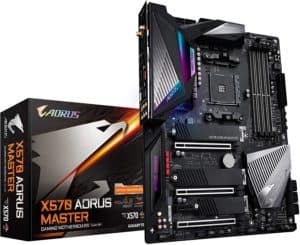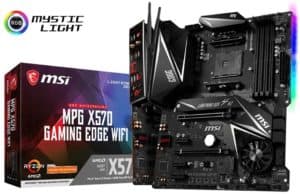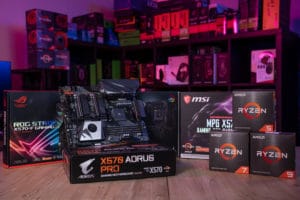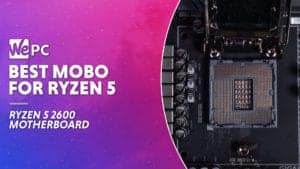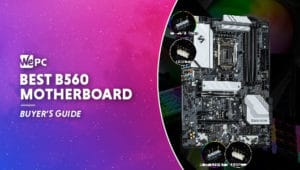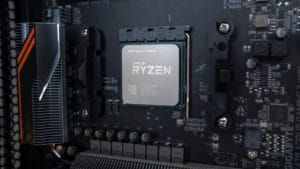Best Motherboard for Ryzen 7 5800X
Five Perfect Motherboards Matches for Getting the Most out of Your Ryzen 7 5800X
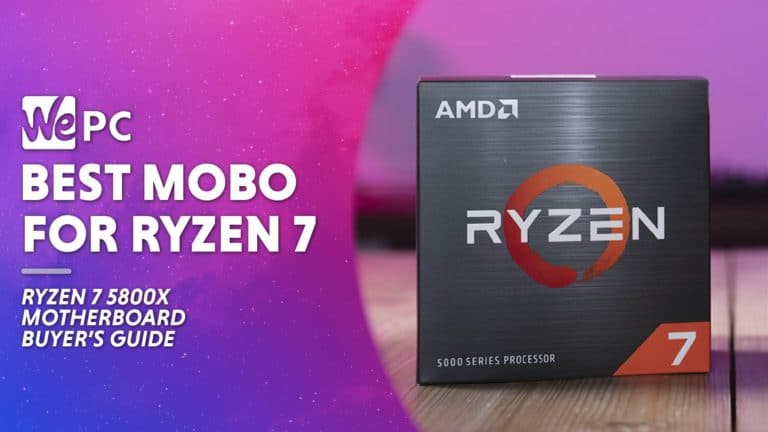
As exciting as the recent release of the Ryzen 7 5800X was, it sent disquiet rippling across entire AMD gaming communities as we began to doubt our current setup’s suitability for use with the new multi-threaded octa-core CPU monster.
Even though one of Ryzen’s proudest, consumer-friendly, and much-appreciated principles up until this point has been backward compatibility, there is a limit to their generosity. It’s great to offer a versatile CPU that works with a myriad of motherboards, but at a certain point, AMD is slowing itself down, so slowly but surely, older motherboard sockets are being cut from the Ryzen team.
AMD kept the AM4 socket in use for so long, and with it came some impressive advancements in motherboard technology, all while sticking to one platform. And although these technologies are a little older now, that doesn’t mean that they still don’t have a lot to give. The 5800X is still an impressive CPUY by any means.
Not to worry though! If you’re planning on treating yourself to the new Ryzen 7 5800X, we’ve got you covered with a list of the five best motherboards you can pair it with to optimize performance.
Our Top Picks
How We Choose
Here at WePC headquarters, we were just as excited for the new Ryzen CPUs as you, not just because computer gaming is our job, but because computer gaming is our lives. We always know which products to share with you because these are the products we either do or are working towards owning as part of our personal gaming rigs.
More specifically, when it comes to motherboards, we’re looking for the ones that are going to let the Ryzen 7 5800X perform to the best of their abilities. We’re looking for chipsets that facilitate such quick and fluent communication, they evoke a feeling of oneness among separate components.
We also consider motherboards at different market levels, opening options up for gamers in different economic situations. The bottom line is, anything that caps this Ryzen CPUs gaming performance is strictly off the table.
Things to Consider
Socket Type
The fundamental aspect of matching up a motherboard with a CPU is the motherboard socket type. As computer technology advances, different connections are required to enable improvements in design and performance. For example, a new CPU may have a totally different power delivery system or memory interface to an older CPU.
A new socket is required because improvements to CPUs are made via physically altering the established matrix in a way that supports new concepts. The Ryzen 7 8500X requires an AM4 socket, but it’s important to note, however, that socket type alone doesn’t ensure compatibility.
Chipset
The chipset of a motherboard is basically the primary communications panel. It allows all connected devices to communicate with each other by managing the dataflow. This is the second motherboard feature you have to pair up with your Ryzen 7 5800X.
The most commonly produced R7 5800X chipsets are the B450 and the X570. Motherboards that feature B450 chipsets tend to be the more budget-friendly option, while those with X570 chipsets are expensive, high-end products. B550, X470, and A520 chipsets are also compatible.
Form factor
The form factor of a motherboard is essentially just its size and shape. You’ll need to decide which is the best for your setup by examining how much space you have available in your computer case.
Measuring 12” x 9.5”, ATX is the largest form factor and is rectangular in shape. ATX formats feature several expansion slots, which is great if you want to connect lots of peripherals simultaneously such as multiple GPUs. Micro ATX is the next smallest form factor, followed by the Mini TX that utilizes a riser card to run expansions in parallel. Micro ATX boards are only used in very small, slimline cases.
Features
Different motherboards support different features, for instance, some may have restrictive power designs that use VRMs that won’t allow you to boost the power to the CPU for overclocking.
Another great quality to assess in a motherboard is networking potential. Does it have integrated wifi? Is that something you’d appreciate? Does it have a decent gigabit ethernet LAN port? This port will define the speed at which the board can send and receive a certain amount of data to and from an internet modem or router, so it’s pretty important for modern gaming.
The Best Motherboard for Ryzen 7 5800X
In-depth Review

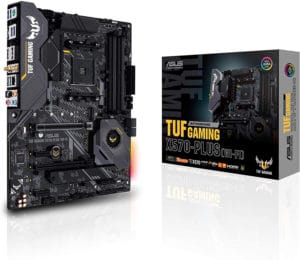
- X570 chipset and PCI-e 4
- Great PCH, VRM, and M.2 heatsinks
- Awesome price for X570 motherboard
- Innovative and efficient power design with plenty amp-potential for overclocking
- Wifi 5
- Gigabit Ethernet LAN
- Only two slots (but that’s a big contributor to the low price)
This Asus motherboard seems to be tailor-made for the R7 5800X, from the AM4 socket down to the power design. By combining all MOSFETs and capacitors into a singular unit, the VRM supplies both the potency and efficiency of power that all 5000 CPUs need to flourish. What’s more, this power design offers you plenty of headroom for overclocking the R7 5800X, and there’s no need to worry about thermals.
With hybrid fan headers and three dedicated heatsinks, the Asus X570-Plus does a fantastic job of creating a hospitable climate for the R7 CPU. In fact, due to the X570 chipset pulling a mammoth 11 watts, Asus has given it its very own miniature fan, which is very impressive.
With dual PCI-e 4 M.2 expansion slots, it’s not the most customizable unit, but the military-grade TUF slot construction couldn’t be more impressive, and the PCI-e 4 connectivity between the CPU and motherboard themselves is going to streamline system communication and improve performance a great deal.
In terms of networking, you can expect integrated wifi 5 connectivity and gigabit ethernet LAN, so whether you prefer a wireless or traditional setup, the Asus AM4 TUF X570-Plus keeps you well and truly connected
- Loads of cooling potential
- Epic build quality
- Individual IOMMUs for all three PCI-e 4 slots
- High-performance pairing
- X570 chipset
- Awesome for OC-ing
- Well designed UEFI
- Single IOMMU for USB and SATA interfaces
The Master is an incredibly upscale motherboard so it may be a little rich for many people’s blood, especially as you’re probably pairing a motherboard purchase with the Ryzen 5000 CPU. If you can stretch for it, though, we guarantee you won’t be disappointed.
Featuring three PCI-e 4 slots, each in its own IOMMU group, you can run a dual GPU setup or connect a variety of peripherals that best suit your gaming needs and wants. Unfortunately, other than PCI-e 4, the connections built into the chipset, namely the USB and SATA interfaces, are piled together into a single IOMMU. It’s not going to hamper performance too badly, it’s just a little inarticulate for an otherwise spectacular board.
As it’s so powerful, the Master does generate quite a bit of heat, but Gigabyte knows what they’re doing in terms of thermals. With 7 fan headers, a dedicated X570 chipset fan, and integrated temperature probes that collaborate with the included software, you can dial in detailed, customized cooling, local to any component.
Build quality couldn’t be better because this is one tough mother! With low-loss PCBs and a ton of copper content, this thing will outlive your CPU, no question. The UEFI is great too, offering fully customizable performance. The Master is simply a fantastic pairing for the 5800X. Together they score a UFO gaming benchmark score of 293 and 109 on the effective CPU speed index.
- Great price for X570 board
- Plenty of power and thermal headroom for OC-ing
- Fantastic FROZR cooling
- Electrostatic slot protection
- 2 x PCI-e 4 slots and 3 X1 slots
- Core and memory boost technology
- Awesome RGB lighting
- Power design isn’t the most effective (but perfectly fine)
Where many budget X570 boards have failed, the MSI MPG succeeds triumphantly. Featuring integrated wifi 5, a ton of USB ports, audio boost 4, two gen 4 PCI-e slots (one M.2 slot routed to the CPU, and the other, the chipset), 2 X16 side slots, 3 X1 slots, and 6 SATA ports, it has all the hallmarks you’d look for in a board of this type.
It also features preinstalled input-output port shielding which is completely grounded to protect both the motherboard itself and your expensive peripherals from electrostatic discharge.
In terms of power design, the doubled 4+2 phrasing isn’t exactly the best, but with the 5800X pulling 105 watts under full load, VRM temps should only peak between 70-75°C, meaning there’s plenty of headroom for overclocking, especially as MSI really treat you when it comes to temperature tech. You get their patented FROZR fan blade design built on a durable dual ball bearing system and impressive heatsinks.
A really neat feature is the memory boost technology that essentially stabilizes signals to facilitate up to 64GBps bandwidth. Needless to say, it’s totally capable of hosting the R7 5800X’s 3200MHz capacity. What’s more, there’s a core boost function that triggers a reserve circuit that injects your CPU with a huge power boost. Your 5800X won’t know what hit it!
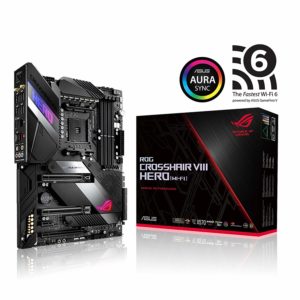
- Premium components
- Safe boot button, slow mode, and LN2 mode for extreme overclocking
- Most impressive cooling solutions on the list
- Wifi 6 and Aquantia 5 gigabit ethernet LAN
- 4 expansions slots
- Designed specifically for Zen 3
- Fantastic AI Suite 3 software
- Quality VRM for handling OC
- Built-in OLED panel
- Very expensive
We’ll preface with a little disclaimer: this board isn’t for everyone. It’s a very high-end, very pricey product, built for those gamers who are constantly chasing the OC dragon. Well, my tweaker friends, this board is the dragon! Kitted out with tons of OC-specific features for mild to extreme boosting, you can let your inner mad scientist out without fear of destroying your expensive gear.
As there’s going to be some serious power running through this board, Asus has gone to huge lengths to ensure thermals are on point. Featuring a Chill EKIII water block, super-wide copper fixtures, dedicated M.2 and PCH heatsinks, four fan connectors, a vented ROG chipset fan, and even a water pump header to accommodate a custom loop, this beast will never overheat.
It’s not just an OC switchboard, though. From the wifi 6 and gigabyte LAN connectivity, right through to the USB 3.2 gen 2 support, it’s pretty impressive on all fronts. The intuitive AI Suite 3 is also exquisitely designed. Fine-tuning performance to perfection for any given application has never been easier.
Aesthetically, it’s a pretty neutral board, but it’s not without flare. The LiveDash OLED panel allows a really cool and colorful customized graphic display, but if that sounds too flashy for you, it can also just be set to display performance information.
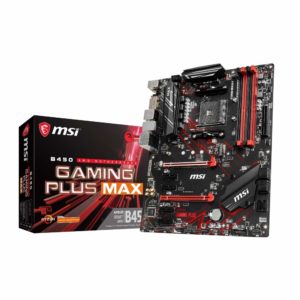
- Massively popular board for 3000 and 5000-Series AMD CPUs
- Huge amounts of cooling potential including a water pump header
- Six PCI-e slots for connecting all your favorite peripherals
- Robust heatsinks
- Core, audio, and memory boost functions
- Great price (cheaper than the Tomahawk but with identical specs)
- B450 chipsets are probably all you’ll need and MSI make some of the best
- No chipset fan required
- No PCI-e 4.0
- SATA ports 5 and 6 shut down if you use the PCI-e slots
Just because this isn’t a super-powered X570 board, doesn’t mean that it’s going to limit your R7 CPU all that much. The only thing you won’t be able to make the most out of is PCI-e gen 4, meaning your connection bandwidth is halved.
Despite the relatively low price and B450 chipset, the Gaming Plus Max is champing at the bit to set the foundation for some intensive overclocking, and that’s all the more emphasized by the thought MSI has put into the cooling facilities.
The heatsinks on this thing are heavy-duty. In fact, we’d say they’re more heat-baths than sinks, and they’re supported by five fan headers spread around the perimeter of the motherboard, but if for some reason, you need to hook up a sixth fan, the water pump header doubles as an extra fan header.
Other features include that lovely stabilized memory signal, and core boost we saw in the X570 MSI motherboard, an audio boost function with top quality Japanese capacitors, a 6 SATA port interface, Four X1 PCI-e slots, and two full-sized PCI-e slots. Keep in mind though, if you’re using the PCI-e ports, you can still use SATA ports 1 through 4, but ports 5 and 6 will shut down
Final Word
With the Ryzen 7 5000X-Series, it’s clear that AMD has hammered another nail in Intel’s coffin. Not only are they beating Intel to every technological punch, but they’re also more affordable, Hurray! And the money you save choosing the AMD CPU, you can put towards one of these motherboards, all of which will really let that awesome Zen 3 Ryzen CPU sing.
Which board is best for your setup and gaming needs is entirely up to you, but in our opinion, the Asus X570 is your best bet. It seems to have all the features a high-end X570 board does such as PCI-e gen 4 slots and quality power design, but at a much more wallet-friendly price. Although, if you’re a serial overclocker, the Crosshair opens up whole new worlds of tweakable performance.
WePC is reader-supported. When you buy through links on our site, we may earn an affiliate commission. Prices subject to change. Learn more

